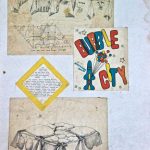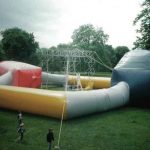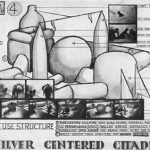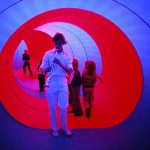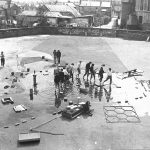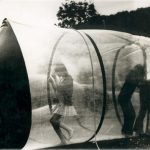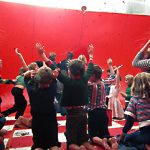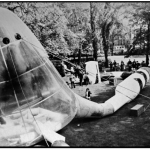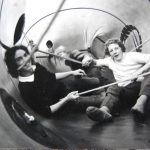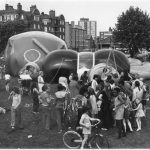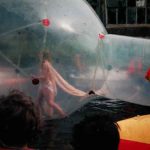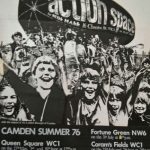Company name: Action Space
Founders: Mary Turner, Ken Turner, Alan Nisbet
Established: 1968
Reason: To change the role of the artist in society, to change the way arts related to society and the way society related to arts, and to champion the role of creative experience in the transformation of society and the education system.
Current status: Disbanded in 1981, reformed as Action Space Mobile in 1981 and is still operating under this name. In Camden another offshoot Action Space London works to engage people with learning disabilities with the visual arts.
Area of work: Combined and visual arts in the community
Policy: Action Space formed at a time when political and social changes were taking place across the country. Action Space was concerned with a number of relatable issues: the commodification of the arts controlled by dealers and investors; the development of high-rise housing estates that they believed would become the ghettos for an under-class; the impact of redevelopment on communities; the lack of spontaneity and community in social life; and the lack of child-centered education and play-space. A period of rapid expansion between 1968 and 1972 led Action Space to define its aims and objectives more clearly: Annual Report Extract.
Structure: Action Space: collective; collective management (1968-1981). Action Space Mobile: Artistic Director-led collective (1981-present)
Based: Action Space, (1968-1983); Piano Factory on Harmood Street in Camden (1971-1973); Institute of Contemporary Arts (1974-1975); Drill Hall on Chenies Street in Camden (1975-1981). Action Space Mobile, Sheffield (1983-1990); Barnsley (1990-present day).
Funding: Arts Council of Great Britain, Inner London Education Authority, the London Boroughs of Tower Hamlets, Westminster, and Camden. They also benefited from many private donations from industry and individuals, of money, materials, and facilities including: Commercial Plastics, Camden Arts Centre, Inter-Action, Kleenex Kimberly Clarke and David Hockney.
Performance venues: Action Space built their own venues, large-scale inflatable structures to be situated in public spaces, with a view to encouraging public participation in combined arts activities. They utilised derelict buildings, festivals, schools, abandoned lots, shopping centres, galleries, parks and streets during their work with young people and adults. Action Space also developed and maintained their own multi-purpose arts venues in Camden, namely the old Piano Factory on Harmood Street and Drill Hall on Chenies Street.
Audiences: Wide-ranging – from children to adults and people with disabilities through to artists and the general public. Action Space audiences covered a wide demographic.
Gallery:
See also Mary Turner’s web page
Company work and process:
In early publicity materials, Action Space described themselves as: ‘An association of artists working in the community, through education and play, developing art forms relevant to a wider public. We use pneumatic, rigid and flexible tent structures, light, sound, movement and drama to create environmental events for children and adults alike.’ (Action Space pamphlet, 1970).
Their first experience of building a structure of this kind for public usage was at The City of London Festival organised by Joan Littlewood in 1968. Ken Turner built a walk-through structure entitled Plastic Garden for inclusion in Littlewood’s Bubble City – a participatory adult playground to be constructed in a shopping precinct. Whilst the structure did not withstand daily attacks from youths in the surrounding Wapping area, the experience spurred Action Space to engage with the young people of Wapping the following summer. They invited artists working in the nearby semi-derelict St Katherine’s Dock studios to join them and embarked upon a three-week summer project in Wapping.
In 1970, Action Space experimented with a movement piece using sticks and Laban techniques, led by Pauline Saul, in a structured environment at a children’s playday in Finsbury Park. The development of other work in this year progressed through performances at festivals and playsites. In the summer they returned to Wapping for another residency and afterwards back to Camden where they continued working with local youths in Jo Benjamin’s Community Play Centres and Arts Lab. They also received some funding to build their first large airhouse, a 20ft cube in orange and green bands built by Richard Harper that ‘dazzled the eyes from the inside like Op Art’ (p42. Action Space Extended). Around this time there were other more politically motivated companies who championed the view that ‘everyone was an artist’, in contrast to this Action Space sought to differentiate between ‘the creativity of every person and the continuing demands that the practice of an artist has to sustain(p.11. Action Space Extended). Artists were going to stimulate creativity not become redundant as far as Action Space were concerned.
In 1971, they began touring their work with inflatable structures extensively at festivals with support from the Arts Council’s new initiative Blow Up ‘71. They travelled with a large pneumatic structure comprised of ‘separate air-houses and tubular corridors of various heights, each house containing a different physical stimulus’ (p43. Action Space Extended). They began trailing this experimental work at the Serpentine Gallery in London (which became an annual event for the company).
In 1972, works were completed at their Harmood Street base and the company utilised the space as a store for their structures and a studio for rehearsals. Many other groups in the area were also using the space for £1 per session. In 1973 they launched their new project Dr Pneuman’s Rocket at the Serpentine Gallery, an inflatable rocket structure accompanied by performances that they later took on tour throughout the country.
In 1974, Camden Council had moved Action Space to the ICA (Institute of Contemporary Arts) where they developed a Soft Room (a gallery space with pneumatic walls and floor) offering a programme of drama, music and movement. Some company members had branched off to try out an experimental project at Groundwell Farm in Swindon. The remaining company members were using street performance as a means to engage with a wider adult public. This was also the year that Action Space began its long commitment to working with people with disabilities. Their work in this area was a growth point for the company and extended into special educational needs schools and special needs adventure playgrounds. Around this time their practice was moving closer to a form of devised theatre; the majority believed this form afforded players a greater awareness of the environment, audience involvement and a unity with the structures. (pp.95-98. Action Space Extended)
In 1975, they moved to Drill Hall on Chenies Street where tensions mounted under the pressure of developing this new space with little funding and it eventually impacted upon the artists, leading to an eventual fragmentation of artistic practices. Later in 1976, they opened the doors to the Drill Hall with a cafe, studios and theatre spaces that could be transformed into Soft Rooms, a dance studio, a video room, a sound studio and a print room. They continued their work with people with special needs in hospitals, special schools and community festivals. In 1977, they built structures to use on water; during their Devon tour they used the sea as a venue and in London they used the canals and they even pushed their inflatable bubble across the River Avon to meet the Queen during her visit to Stratford. This was also the year they converted an old lifeboat to run a week-long programme of performances and events for four people from a long-stay hospital.
By 1978, over 300 people were using the Drill Hall for workshops, performances and rehearsals or to eat in the cafe. When Action Space Mobile formed in 1981, the company were back on the road embarking upon a summer tour, which included three-week residencies and events in both indoor and outdoor venues. They performed across Northern England and by 1982 had moved their base to Sheffield, where they performed and ran workshops extensively until they relocated to Barnsley in 1990.
For more Action Space work details open here.
Personal appraisal & thoughts:
Mary Turner: ‘It is worthwhile to look back at the dreams and ambitions that fired the start of the company and see where it has led us. What was an experimental way for artists to work in the beginning is now an accepted career choice and has training programmes to go with it. We said we wanted artists to work with the community on a non-star basis where everyone was paid equally a living wage. We wanted artists to escape from the stardom of high prices led by dealers and investors. This has to some degree, come about and we earn a living, are paid equally if inadequately, but in return often have to work on projects that fulfill other’s agendas. All too often it is following the government’s or funders’ criteria rather than challenging the development of our society.’ (p281., Turner. Action Space Extended)
Reviews:
‘This structure served as an imaginative framework for play…’ (Hackney Gazette 1969)
‘Action Space’s new show Donkey is a most affecting and effective example of surrealist, impressionistic performance art.’ (Time Out, 23rd March 1978)
‘If revolution really is the festival of the oppressed, the Drill Hall must be London’s most insurrectionary venue’ (Time Out 1978)
Productions: Action Space have an extensive body of work spanning over 42 years, please click here for an overview of their productions and projects between 1968 and 1988. For details of later performances and events run by Action Space Mobile, please visit the University of Sheffield’s extensive archive collection and/or purchase Mary Turner’s book: Action Space Extended which chronicles the rich history of Action Space and Action Space mobile.
Interviewee reference: Mary Turner and Julie Parker
Links: Action Space Mobile website, Facebook. Action Space London website, Facebook, Twitter, Vimeo channel, Imaginative Eye.
Existing archive material: University of Sheffield Library. Special Collections and Archives: Action Space Extended
Reason for disbanding and reorganisation: Action Space ceased trading in 1980 when the Thatcher regime cut vital funding to the company. The financial impact of this, along with administrative pressures associated with running a large company with open policies, forced the company to close the Drill Hall to the public in 1980. In 1981, the nine remaining members of Action Space decided to stay on in Drill Hall, rent and rate free from Camden Council, and split the activities they offered into three companies: the Drill Hall reopened as a venue; Action Space (London Events) was formed to direct their London-based children’s and disability work; and Action Space Mobile for their touring performances and residences. Action Space (London Events) and Action Space Mobile are currently trading under the rubric of Action Space Ltd. The Drill Hall finally closed and was taken over by RADA in 2013.
Bibliography:
Action Space Extended, Action Space Pamphlet (Archive item 426/2/6, University of Sheffield Library 1970-71)
Action Space Extended by Mary Turner (Createspace 2012)
Crashing Culture 1954-2016: Artist Notebook – Performance Artist and Painter by Ken Turner (The Imaginative Eye & Eye Projects, 2016)
A Life Being Ken Turner by Ken Turner (studiobarns, 2020)
Action Space Extended: a film by Huw Wahl (2016): here
Archive at: University of Sheffield:
Acknowledgements: This webpage was written and constructed by Emma Jackson (Unfinished Histories) with the help of Dr Jo Stanley (Oral Historian and principal interviewer for the Mary Turner interview), Mary Turner (Action Space co-founder), Sheffield University Special Collections. November 2013
The creation of this page was supported by the National Lottery through the Heritage Lottery Fund.

